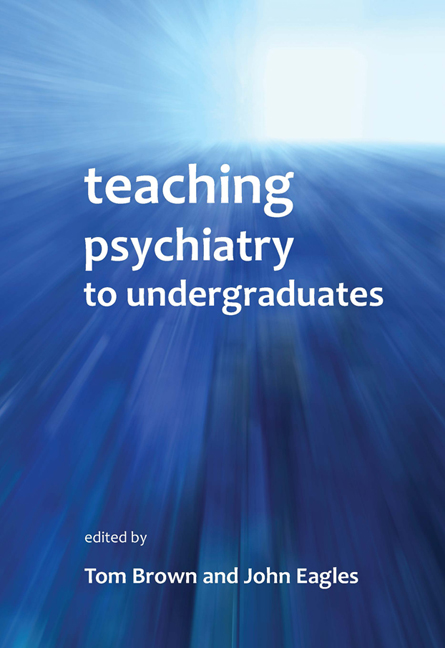Book contents
- Frontmatter
- Contents
- List of figures, tables and boxes
- List of contributors
- Preface
- Foreword
- 1 How do students learn?
- 2 Recent developments in undergraduate medical education
- 3 Undergraduate psychiatry teaching – the core curriculum
- 4 The organisation of undergraduate teaching
- 5 Assessment of undergraduates in psychiatry
- 6 Using computers to teach undergraduate psychiatry
- 7 How to give a lecture
- 8 How to do small-group teaching
- 9 Problem-based learning
- 10 Teaching trainee psychiatrists how to teach medical students: the Southampton model
- 11 Involving trainees in teaching
- 12 Involvement of service users in psychiatric education
- 13 Time-efficient clinical teaching
- 14 Intercalated degrees
- 15 Undergraduate experiences of psychiatry: a student view
- 16 Integration: teaching psychiatry with other specialties
- 17 Teaching the teachers in a cross-cultural setting: the Scotland–Malawi Mental Health Education Project
- 18 International undergraduate teaching
- 19 Teaching with simulated patients and role-play
- 20 Undergraduate medical education and recruitment to psychiatry
- 21 Choosing psychiatry: factors influencing career choice among foundation doctors in Scotland
- 22 Funding of the teaching of medical undergraduates
- 23 Dealing with students in difficulty
- 24 Training medical students to promote good mental health in secondary schools
- 25 Women in medicine
- Index
9 - Problem-based learning
- Frontmatter
- Contents
- List of figures, tables and boxes
- List of contributors
- Preface
- Foreword
- 1 How do students learn?
- 2 Recent developments in undergraduate medical education
- 3 Undergraduate psychiatry teaching – the core curriculum
- 4 The organisation of undergraduate teaching
- 5 Assessment of undergraduates in psychiatry
- 6 Using computers to teach undergraduate psychiatry
- 7 How to give a lecture
- 8 How to do small-group teaching
- 9 Problem-based learning
- 10 Teaching trainee psychiatrists how to teach medical students: the Southampton model
- 11 Involving trainees in teaching
- 12 Involvement of service users in psychiatric education
- 13 Time-efficient clinical teaching
- 14 Intercalated degrees
- 15 Undergraduate experiences of psychiatry: a student view
- 16 Integration: teaching psychiatry with other specialties
- 17 Teaching the teachers in a cross-cultural setting: the Scotland–Malawi Mental Health Education Project
- 18 International undergraduate teaching
- 19 Teaching with simulated patients and role-play
- 20 Undergraduate medical education and recruitment to psychiatry
- 21 Choosing psychiatry: factors influencing career choice among foundation doctors in Scotland
- 22 Funding of the teaching of medical undergraduates
- 23 Dealing with students in difficulty
- 24 Training medical students to promote good mental health in secondary schools
- 25 Women in medicine
- Index
Summary
Introduction
Education: that which reveals to the wise, and conceals from the stupid, the vast limits of their knowledge. (Mark Twain)
Problem-based learning (PBL) was introduced as a teaching method in undergraduate medical education at McMaster University Medical School, Ontario, in 1969. Since then it has been integrated into medical curricula worldwide and has been endorsed by bodies such as the World Health Organization (Spencer & Jordan, 1999); it was first adopted in Europe by the University of Maastricht Medical School in 1974. In response to the recommendations made by the General Medical Council (1993) in Tomorrow's Doctors, in 1996 the University of Glasgow was the first UK medical school to adopt PBL as the core educational method in the medical undergraduate curriculum. Around 30% of medical schools in the UK have since moved to a PBL curriculum.
Considerable research has examined the effectiveness and outcomes of PBL curricula. Although it seems early to suggest that the approach encourages recruitment into psychiatry, there is evidence that PBL has specific advantages in the acquisition of skills relevant to the specialty and that it may improve performance in psychiatric examinations.
What is problem-based learning?
Strategies for PBL were developed as part of an exploration of educational theories of adult learning. There is an emphasis on active learning, facilitated by a constructive, self-directed, collaborative and contextual learning process (Dolmans et al, 2002). Key concepts within PBL are that its use with small groups should enable students to explore their existing knowledge, identify gaps, carry out independent learning and return to the group to discuss and share this new knowledge. This allows students to establish links more readily between different learning experiences and the process equips the student with skills that can be applied to self-directed, lifelong learning.
Despite the strong theoretical basis behind PBL, its use in medical schools has been shown to be heterogeneous, in terms of both the format used and the amount of PBL within various curricula (Maudsley, 1999; Kelson & Distlehorst, 2000). Regardless of these differences, three common features of PBL occur across medical undergraduate curricula:
• students work in small groups
• learning is activated by clinical problems
• a facilitator has a key role.
- Type
- Chapter
- Information
- Teaching Psychiatry to Undergraduates , pp. 110 - 118Publisher: Royal College of PsychiatristsPrint publication year: 2011



